CO2 Adsorption Reactions of Synthetic Calcium Aluminum Ferrite (CAF)
Abstract
:1. Introduction
2. Experiment
2.1. Materials
2.2. Method
2.2.1. Sintering
2.2.2. Carbonation
3. Result and Discussion
3.1. Characterization of the Synthetic SCAF
3.2. Characteristics of Carbo Reaction of SCAF
3.2.1. Analysis of Thermal Properties by Carbo Reaction of SCAF
3.2.2. Analysis of Crystalline Phase for Carbo Reaction of SCAF
3.2.3. Image Analysis of SCAF
4. Conclusions
- (1)
- As a result of Rietveld-XRD analysis by firing CAF compounds at sintering temperatures of 1000 °C and 1100 °C, CF- and CA-based products (about 87.3%) accounted for the major proportion at 1100 °C, and at 1000 °C, CF- and CA-based products accounted for 64.6% in total.
- (2)
- In the carbonation of SCAF with the wet method, the peak intensity of the products by carbonation was larger than that in the dry carbonation, and regardless of the synthesis temperature of the CAF compound, from 3 h of the reaction time, as hydration products from reactions of the CAF compound with CO2, formation of CAC(Ca4Al2O6CO3·11H2O) and CACH(Ca4Al2O6CO3·11H2O), which are the calcium carbo aluminate compounds, and CFC(Ca4Al2Fe2O12CO3(OH)2·22H2O), the calcium carbo alumino-ferrite compound, was confirmed.
- (3)
- In the case of carbonation with the wet method, CAH and CAFH, which are hydrates, are produced in up to 1 h of reaction time, but from 3 h of reaction time, calcium carbo aluminate and calcium carbo alumino-ferrite compounds, which are carbo compounds, are formed by carbonation.
- (4)
- Irrespective of the SCAF synthesis temperature, SCAF reacts with CO2 to produce calcite and calcium carbo compounds, and the carbonation reaction becomes more active over time.
Author Contributions
Funding
Conflicts of Interest
References
- Song, D.S.; Leigh, S.B. A Study for Estimating Environmental Load Throughout Building Life Cycle. J. Archit. Inst. Korea 1997, 13, 175–183. [Google Scholar]
- Korea Institute of Construction Technology. Development and Application of Cement-Zero Concrete; Korea Institute of Construction Technology: Goyang, Korea, 2008. [Google Scholar]
- Javier, F.; Mahdi, F.; Breyer, C. Trends in the global cement industry and opportunities for long term sustainable CCU potential for power to X. J. Clean. Prod. 2019, 217, 821–835. [Google Scholar]
- Hwang, K.R. Current Technical Tendency of Concrete Using Fly Ash. Mag. Korea Concr. Inst. 2002, 14, 96–103. [Google Scholar]
- Theodore, H.; Fredrik, P.G.; Marcus, B. Thermodynamics of Portland Cement Clinkering. In Proceedings of the 14th International Congress on the Chemistry of Cement, Beijing, China, 13 October 2015. [Google Scholar]
- Rose, J.; Benard, A.; el Mrabet, W.; Masion, A.; Moulin, I.; Briois, V.; Olivi, L.; Bottero, J.Y. Evolution of rion speciation during hydration of C4AF. Waste Manag. 2006, 26, 720–724. [Google Scholar] [CrossRef] [PubMed] [Green Version]
- Carlson, E.T. Action of water on calcium aluminoferrites. J. Res. Natl. Bur. Stand. A. Phys. Chem. 1964, 68, 453. [Google Scholar] [CrossRef] [PubMed]
- Chen, C.H.; Chiou, I.J.; Wang, K.S. Sintering effect on cement bonded sewage sludge ash. Cem. Concr. Compos. 2006, 28, 26–32. [Google Scholar] [CrossRef]
- Lucia, A.R.; Geratd, P.; Etienne, M.; Alain, E. The use of thermal analysis in assessing the effect of temperature on a cement paste. Cem. Concr. Res. 2005, 35, 609–613. [Google Scholar]
- Song, Y.; Liu, J.; Evrendilek, F.; Kuo, J.; Buyukada, M. Combustion behaviors of Pteris vittata using thermogravimetric, kinetic, emission and optimization analyses. J. Clean. Prod. 2019, 237, 117772. [Google Scholar] [CrossRef]
- Radwan, M.M.; El Hemaly, S.A.S. Hydration characteristics of tetracalcium alumino ferrite phase in the presence calcium carbonate. Ceram. Silik. 2011, 55, 337–342. [Google Scholar]
- Dilnesa, B.Z.; Lothenbach, B.; Le Saout, G.; Renaudin, G.; Mesbah, A.; Filinchuk, Y.; Wichser, A.; Wieland, E. Iron in carbonate containing AFm phases. Cem. Concr. Res. 2011, 41, 311–323. [Google Scholar] [CrossRef]
- Noworyta, C.V. Mechanisms of Limestone Reactions in the System (C3A-CSH2-CH-CC-H): Competition Between Calcium Monocarbo- and Monosulfo-Aluminate Hydrates Formation. In Proceedings of the 9th International Congress of the Chemistry of Cement, New Delhi, India, 23–28 November 1992; Volume 5, pp. 430–436. [Google Scholar]

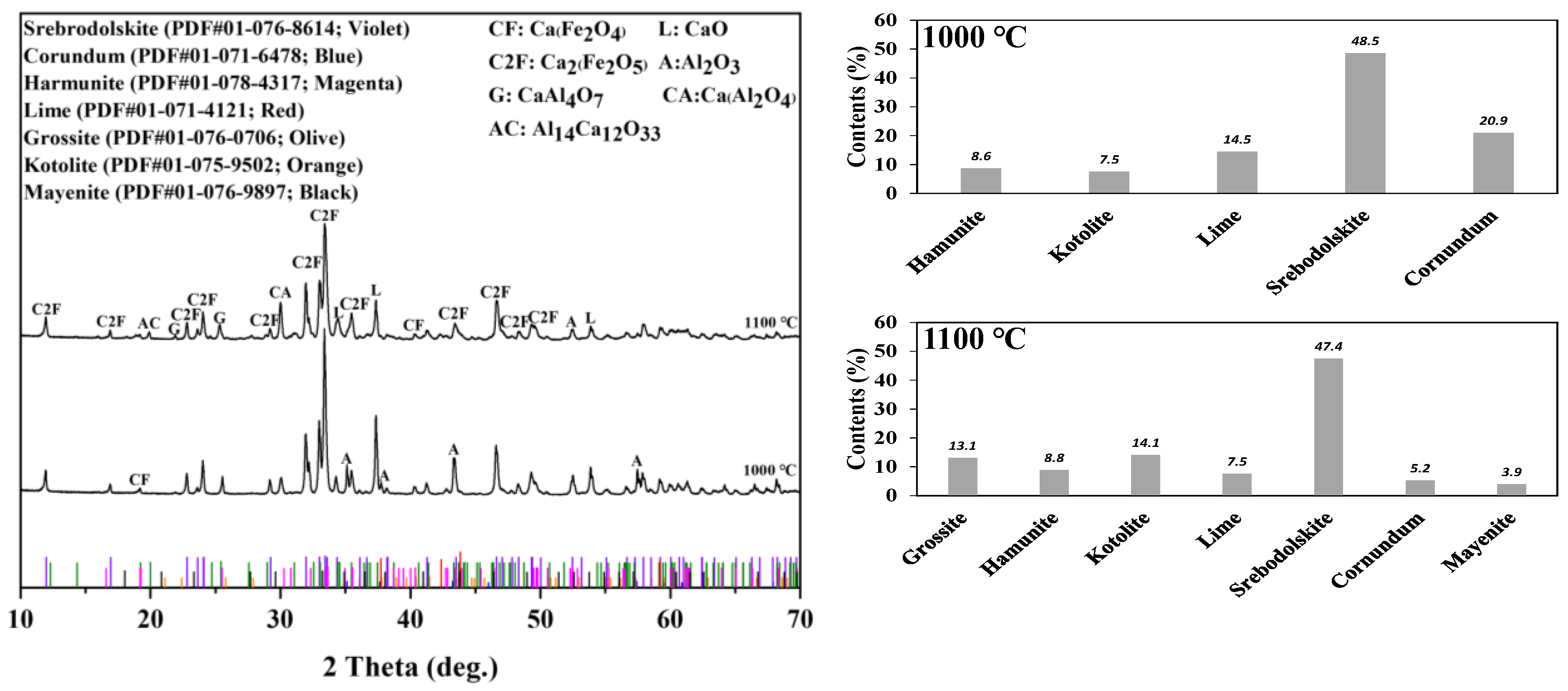
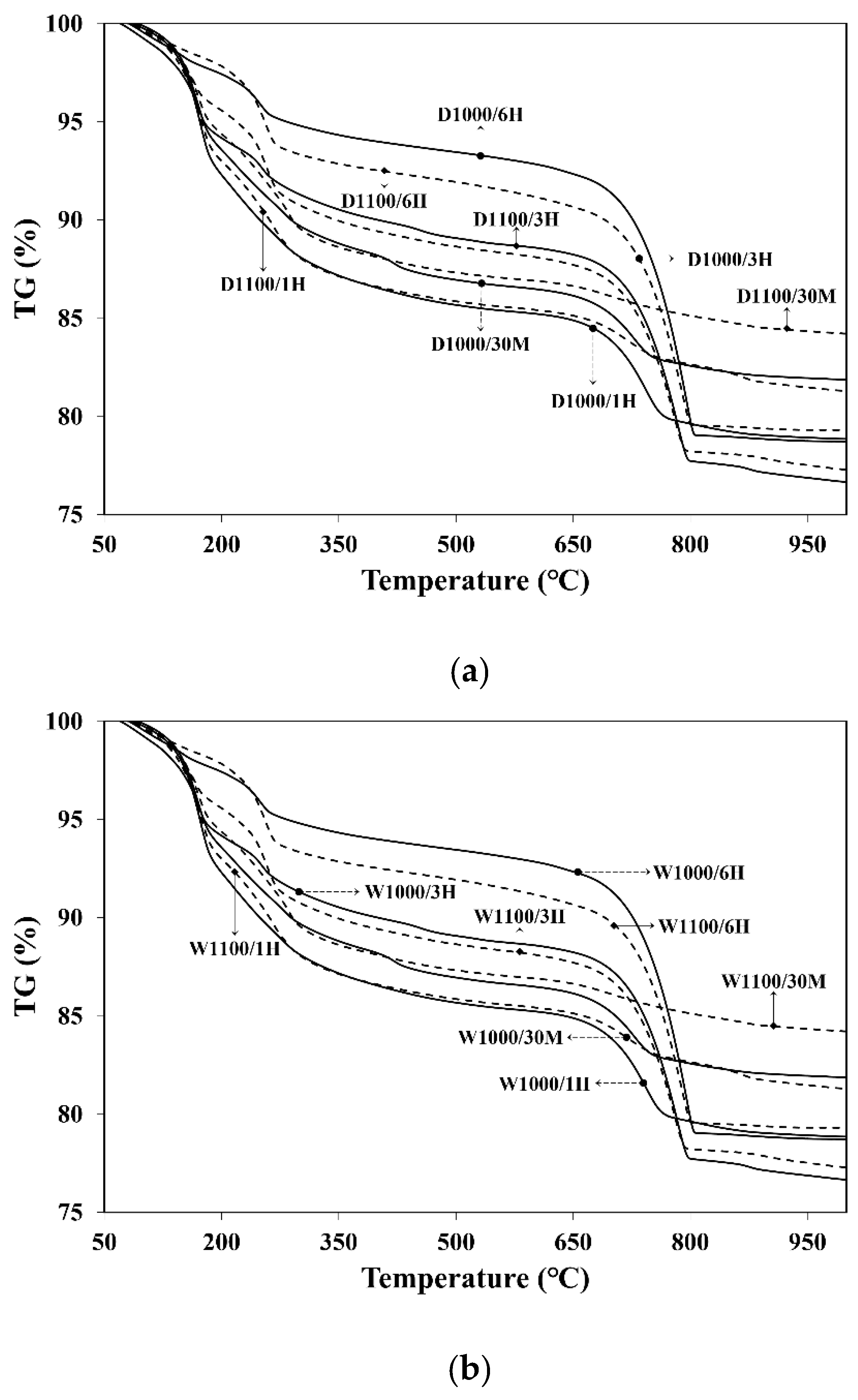
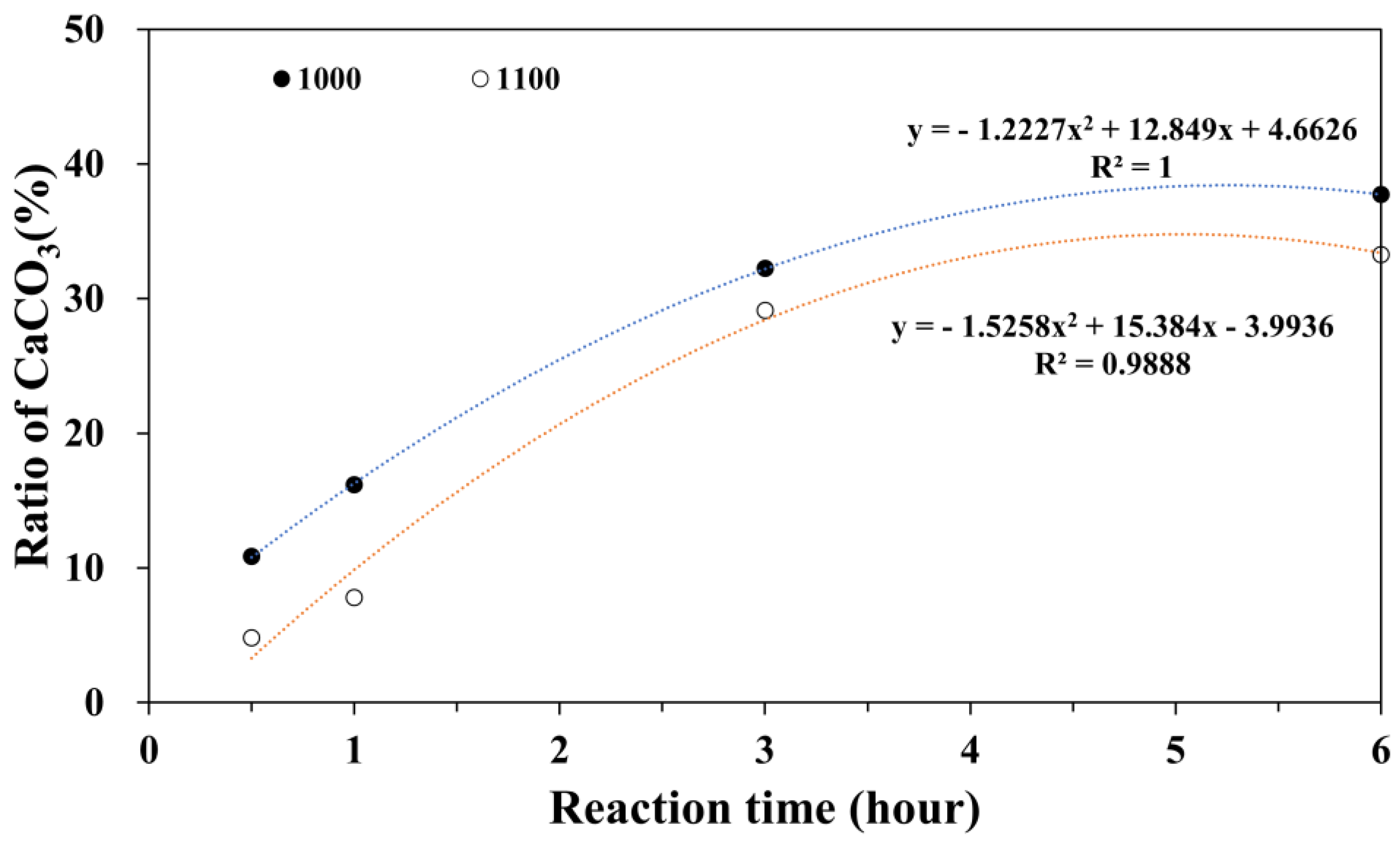
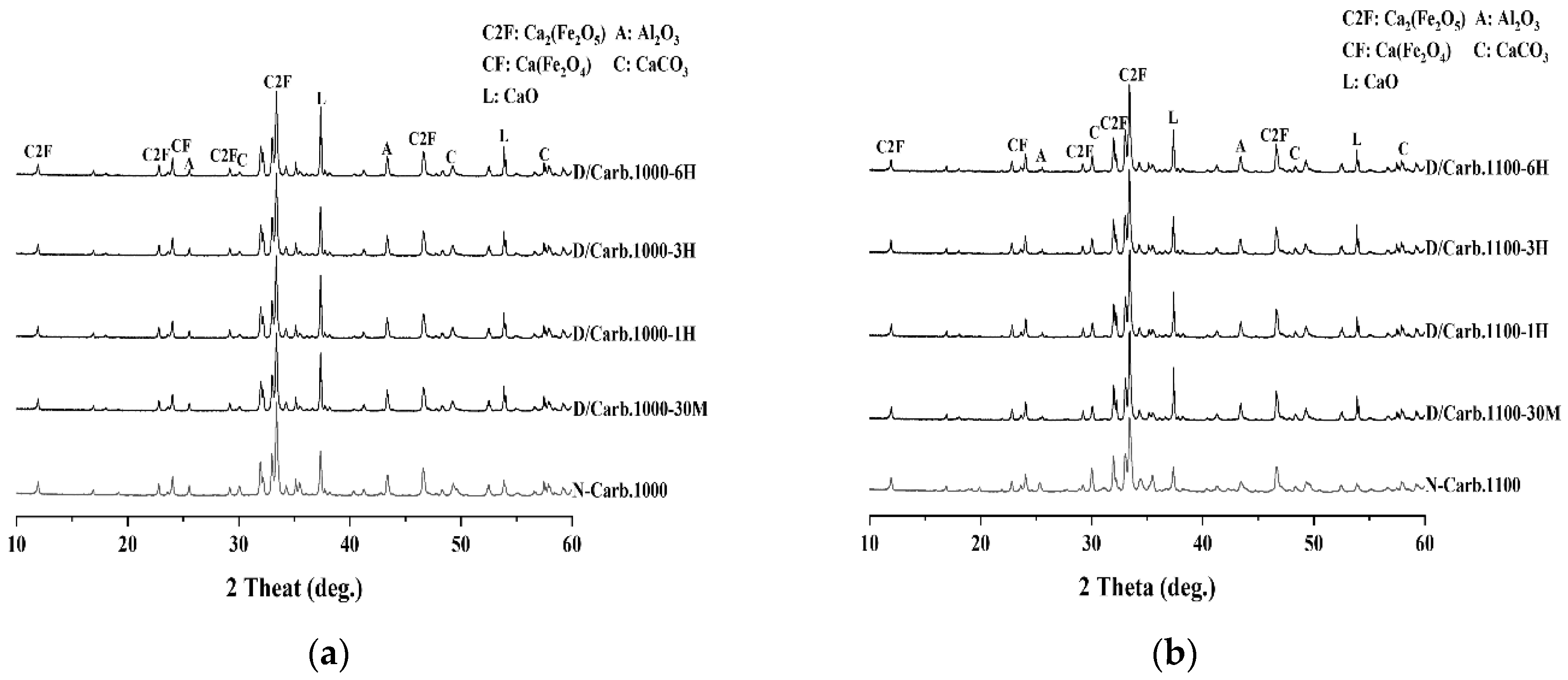
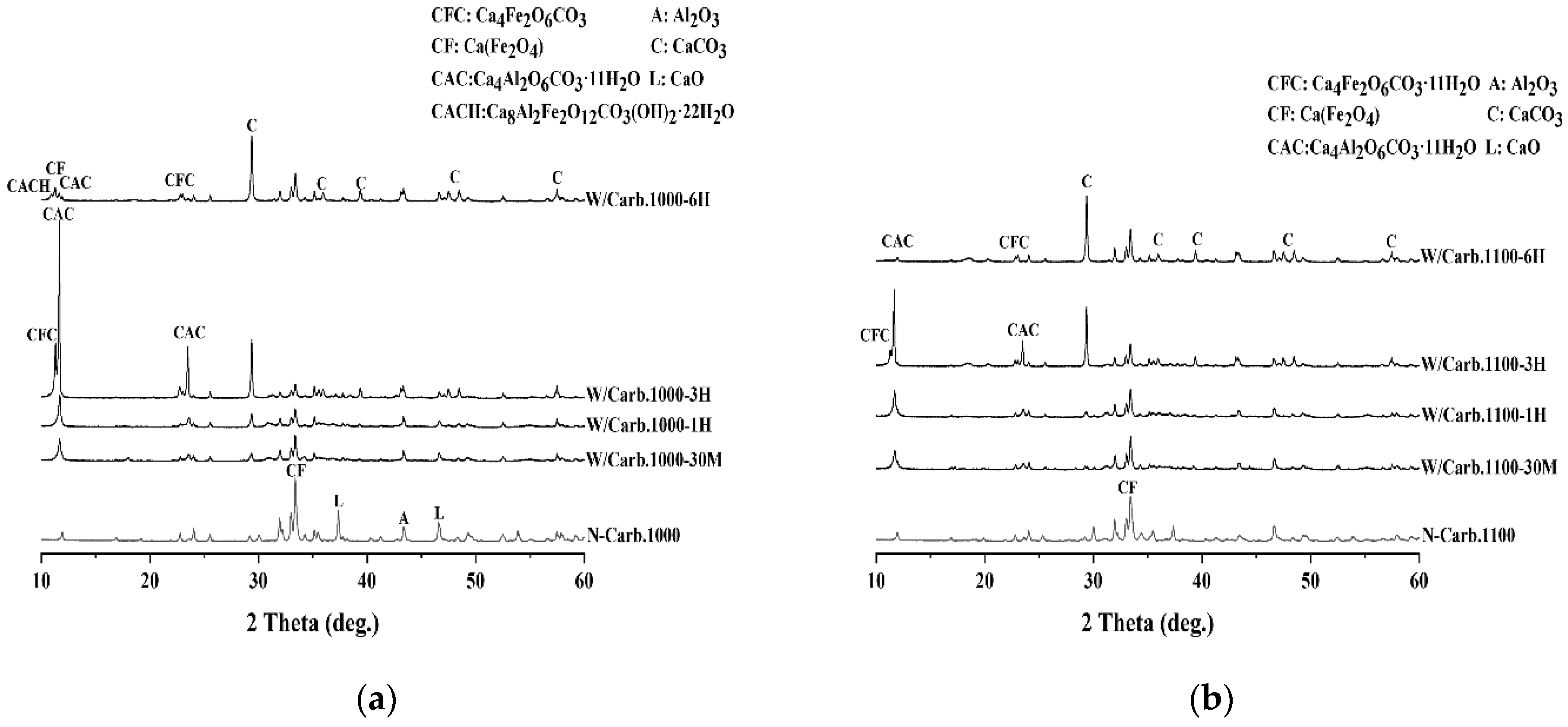
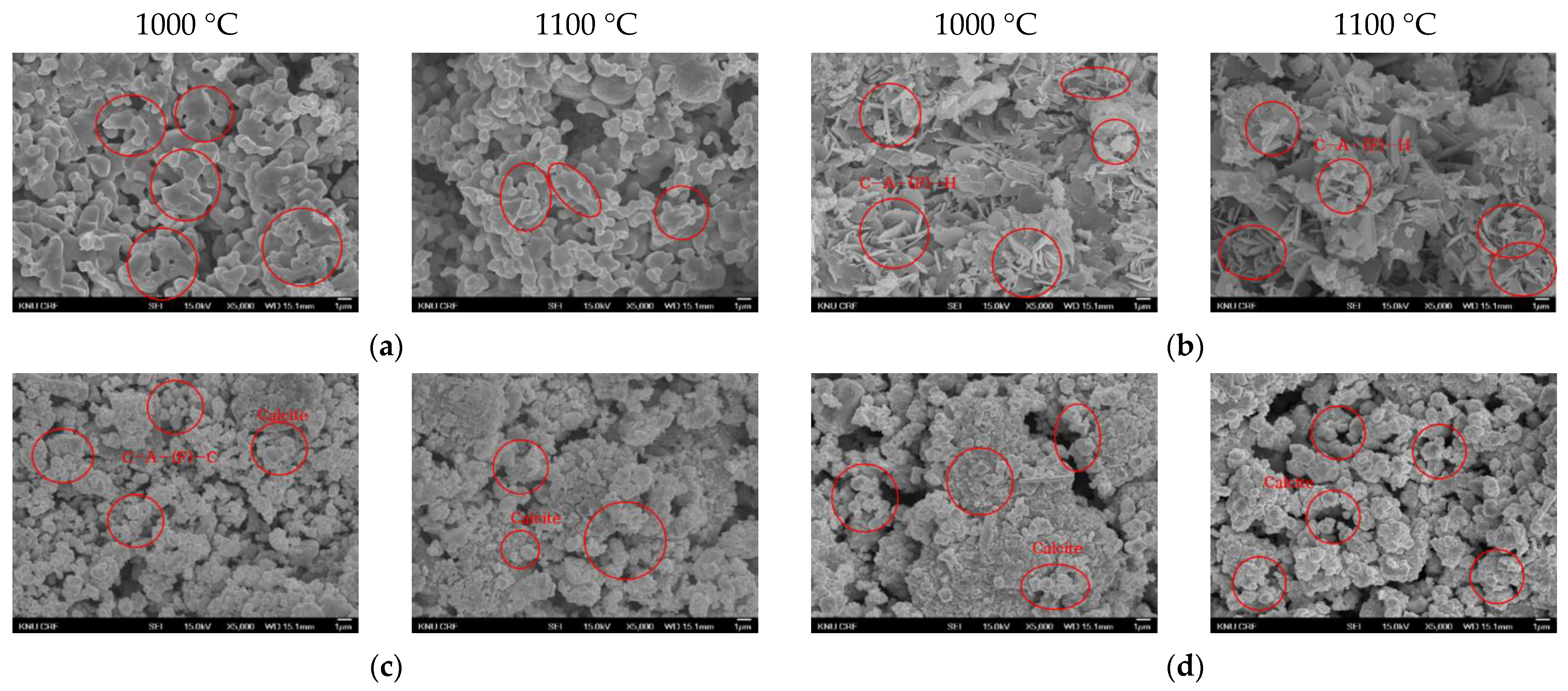
| 1000 °C | 1100 °C | ||||||
|---|---|---|---|---|---|---|---|
| Reaction Time | Method | 1st Section 100~200 °C | 2nd Section 350~500 °C | 3rd Section 600~900 °C | 1st Section 100~200 °C | 2nd Section 350~500 °C | 3rd Section 600~900 °C |
| 30 min | D | 0.56 | 0.24 | 0.05 | 0.54 | 0.38 | 0.11 |
| W | 12.22 | 1.81 | 5.22 | 6.32 | 7.27 | 2.82 | |
| 1 h | D | 0.41 | 0.37 | 0.04 | 0.36 | 0.52 | 0.19 |
| W | 8.69 | 6.56 | 6.51 | 7.89 | 7.14 | 4.28 | |
| 3 h | D | 0.47 | 0.22 | 0.18 | 0.40 | 0.54 | 0.22 |
| W | 6.86 | 5.03 | 12.03 | 4.97 | 7.34 | 11.01 | |
| 6 h | D | 0.43 | 0.47 | 0.02 | 0.37 | 0.93 | 0.02 |
| W | 6.89 | 1.33 | 13.67 | 2.27 | 6.12 | 12.93 | |
Publisher’s Note: MDPI stays neutral with regard to jurisdictional claims in published maps and institutional affiliations. |
© 2022 by the authors. Licensee MDPI, Basel, Switzerland. This article is an open access article distributed under the terms and conditions of the Creative Commons Attribution (CC BY) license (https://creativecommons.org/licenses/by/4.0/).
Share and Cite
Lee, W.-G.; Song, M.-S. CO2 Adsorption Reactions of Synthetic Calcium Aluminum Ferrite (CAF). Appl. Sci. 2022, 12, 6677. https://doi.org/10.3390/app12136677
Lee W-G, Song M-S. CO2 Adsorption Reactions of Synthetic Calcium Aluminum Ferrite (CAF). Applied Sciences. 2022; 12(13):6677. https://doi.org/10.3390/app12136677
Chicago/Turabian StyleLee, Woong-Geol, and Myong-Shin Song. 2022. "CO2 Adsorption Reactions of Synthetic Calcium Aluminum Ferrite (CAF)" Applied Sciences 12, no. 13: 6677. https://doi.org/10.3390/app12136677
APA StyleLee, W.-G., & Song, M.-S. (2022). CO2 Adsorption Reactions of Synthetic Calcium Aluminum Ferrite (CAF). Applied Sciences, 12(13), 6677. https://doi.org/10.3390/app12136677






